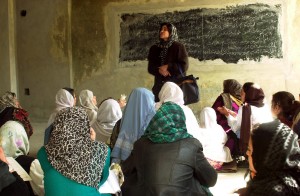Educating females is a profitable investment that generates high economic returns. An educated woman will be three times less likely to contract HIV/AIDS than her uneducated sister, and her income will be 25% higher. Moreover, Rebecca Winthrop, Director of the Center for Universal Education, told the HPR, “Every 1 percent increase in women’s education generates a .3 percent increase in economic growth.” While some countries are starting to take measures to close the education gap between boys and girls, social and cultural structures still present barriers to girls’ education and women’s employment. Until societies shift their collective attitudes toward women and their capabilities, the education gap will never be closed and women, along with the societies they live in, will never be able to reach their full potential.
In an interview with the HPR, Sheryl WuDunn, co-author with husband and New York Times columnist Nicholas Kristof of Half The Sky: Turning Oppression Into Opportunity for Women Worldwide, quoted Lawrence Summers, when he was Chief Economist of the World Bank, as saying “The question is not whether countries can afford this investment, but whether countries can afford not to educate more girls.” The work of CAMFED, the Campaign for Female Education, a non-governmental organization committed to overcoming poverty in Africa through female education, hinges on this conviction.
Ann Cotton, the CEO and founder of CAMFED, recounted to the HPR her initial visit to Zimbabwe, where she found that “families were making rational decisions based on the socio-economic reality. [Zimbabwe] favored male education because boys had more opportunities to find work.” Cotton argues that we need to “shift the way of thinking, so girls can also be breadwinners and not just caretakers.” This example illustrates how specific cultural and social settings can influence the educational opportunities afforded to girls. Strategies to improve education for girls must therefore be local. In her native Haiti, former Prime Minister Michèle Pierre-Louis told the HPR, “Nationwide, there is no sign that girl’s education is a priority.”
Fernando Reimars, professor at the Harvard Graduate School of Education, noted that Mexico and other Latin American countries offer equal access to education but are still patriarchal societies where women do not hold high ranking positions. The ‘machismo’ complex of male-dominated societies contributes to the idea of women holding submissive or lower positions in the workforce. As in Zimbabwe, families do not see their daughters as economic assets and pay more attention to the education of their sons.
There is a vicious cycle which continues to marginalize women: Girls have less access to education than boys do, so women cannot compete with men for work outside the home; likewise, women have fewer opportunities to find work than men do, so families rationally choose to allocate their limited resources to educating their sons.
Ways Out of the Cycle
It is not impossible to escape this vicious cycle. WuDunn offered China as an example of a nation which has fundamentally altered conditions for its female population. The traditional practice of foot binding was eradicated within a generation, it is mandated that all girls receive an education, and factory doors were opened to female workers. Similarly, Reimars lauded the implementation of ‘Oportunidades’ by the Mexican government a decade ago; the initiative offers ‘scholarships’ to compensate families that send their daughters to school in lieu of sending them to work, and it has increased girls’ attendance in schools nationwide.
Schools can also do some small things to welcome female students. Reimars noted that, statistically, schools with female principals foster more “inclusive educational cultures” for female students. WuDunn added as an example the fact that if girls are not provided with sanitary pads, menstruation can prevent them from attending school.
While education is valuable for its own sake, the primary goal of improving girls’ access to education is to allow women to contribute more to their societies than they can today. As a contrast with China, the women of Saudi Arabia have access to education but are not afforded the same vocational freedoms, WuDunn told the HPR.
For a society to benefit from the full potential contribution of its entire population—not just the half with a Y chromosome—it must shift its notions of what makes women’s work. The need to change perceptions could not be more pressing. “For every girl that doesn’t go to school,” Cotton said, “there is a family living in poverty.” Until these perceptions are confronted, the gender gap will not be closed. Pierre-Louis optimistically surmised, “There is a positive but slow trend…we have to advocate more. The trend is there.”
